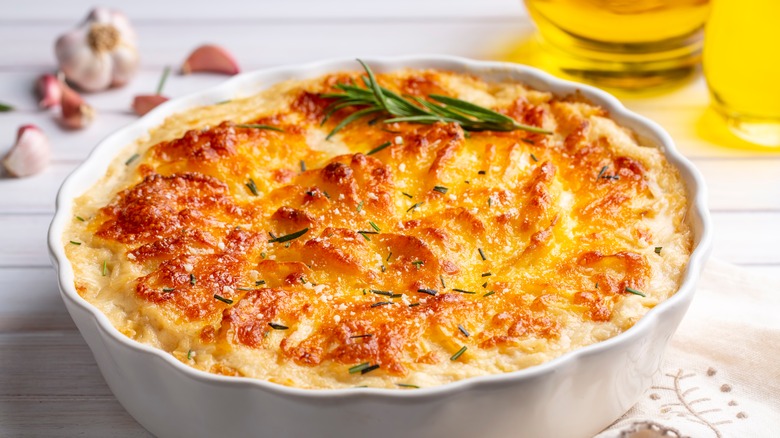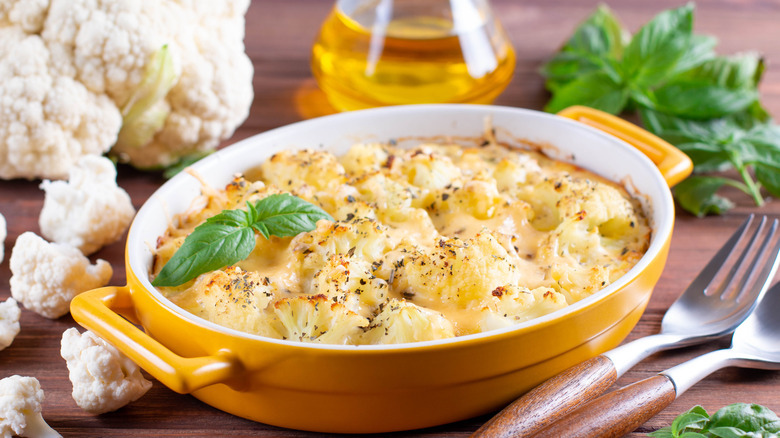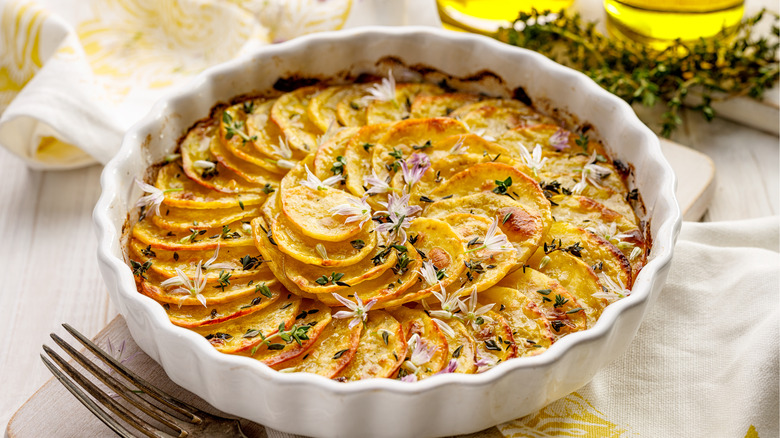One Ingredient Differentiates Scalloped And Gratin Potatoes
Thinly sliced potatoes baked with heavy cream and cheese? Yes, please. Scalloped potatoes and gratin potatoes are some of the most beloved of all the side dishes, and — besides the trouble of thinly slicing potatoes — they're also fairly easy to prep and put together. Once you have everything assembled in a casserole dish, the oven does all the work of thickening the sauce and slowly cooking the potatoes to peak tenderness.
At first glance, it's easy to think that scalloped potatoes and gratin potatoes are the same. They're both made with thin slices of potatoes and baked in the oven, and they both appear on holiday tables and special occasions like Easter and Christmas dinner. In fact, in some parts of North America, scalloped potatoes are called "funeral potatoes," because they're a reliably yummy comfort potluck dish that can handle any stage of grief eating.
But while scalloped and gratin potatoes look similar (and show up to many of the same parties), they are not actually the same dish. You actually shouldn't use their names interchangeably. The biggest difference between the two is that gratin potatoes are always made with cheese. But that's not the only thing that sets the two dishes apart.
Gratin facts
According to The Oxford Companion to Food, "au gratin” is a French term that is often interpreted as a dish with grated cheese, probably because the words come from the French words grater or gratter, which means "to grate." Gratin, however, is just a simple cooking technique of making a dish with a browned crust. You can achieve this with cheese, breadcrumbs, or some combination of the two using either a hot oven or a salamander.
Perhaps the most telling clue that gratin is a technique (rather than a recipe) is that the flat, oval-shaped baking dishes used to make them are also called gratins. They're usually made out of either heavy, oven-safe ceramic, cast iron, or tri-ply stainless steel so that they can withstand the high heat needed to brown the top of the casserole.
While it is most often associated with potatoes, there's actually nothing in the definition of gratin that says you have to use potatoes. In fact, you can make a gratin from all kinds of vegetables, including broccoli or cauliflower, fennel, swiss chard, celery root, and more. All you need to do to make a gratin is slice your vegetables very thin (a mandoline is perfect for this job), layer them in a casserole dish with a cream sauce, then top with cheese and breadcrumbs and bake. When the potatoes (or other vegetables) are cooked through, flash the dish under the broiler to give it a nice brown crust.
Scalloped potato stats
Scalloped potatoes, in comparison, aren't usually made with any cheese or breadcrumbs, and only require a few ingredients. The basic technique is to bake thinly-sliced potatoes in a heavy cream sauce (usually made with a roux), that can be seasoned with herbs or onions. The dish is baked until the potatoes are cooked though and the top is golden brown, and that's pretty much it. You can use a gratin dish, however, the potatoes are usually sliced a little thicker than with a gratin, so the casserole is a little deeper. You can also just use a regular square, round, or rectangular baking pan.
The dish gets its name from an Old English word, "collop," which is derived from the French word "escalope," and has nothing to do with shellfish. According to the Oxford English Dictionary "escalope" is "a thin slice of meat without any bone." Some creative chef a long time ago must have seen the similarity between thinly sliced potatoes and thinly sliced meat and called the dish scalloped potatoes.
It could be argued that the two types of potatoes are more or less the same dish, or at least that scalloped potatoes are all gratins. If you want to be culinarily correct, however, just remember — unless your gratin has cheese, it's simply scalloped potatoes.


